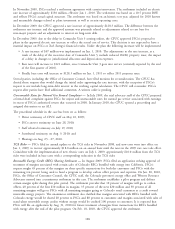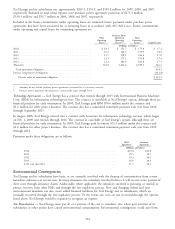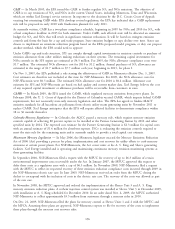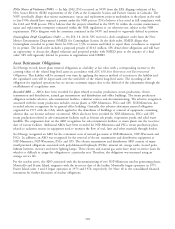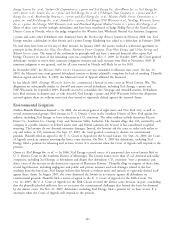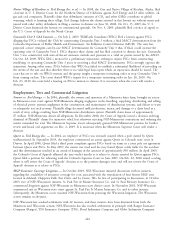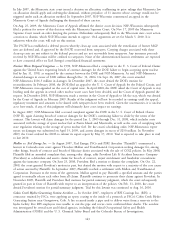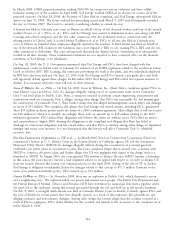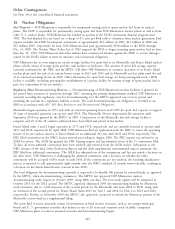Xcel Energy 2009 Annual Report Download - page 145
Download and view the complete annual report
Please find page 145 of the 2009 Xcel Energy annual report below. You can navigate through the pages in the report by either clicking on the pages listed below, or by using the keyword search tool below to find specific information within the annual report.various situations, including sites of former MGPs operated by Xcel Energy subsidiaries, predecessors, or other entities;
and third-party sites, such as landfills, for which Xcel Energy is alleged to be a PRP that sent hazardous materials and
wastes. At Dec. 31, 2009, the liability for the cost of remediating these sites was estimated to be $102.1 million, of
which $6.3 million was considered to be a current liability.
MGP Sites
Ashland MGP Site — NSP-Wisconsin has been named a PRP for creosote and coal tar contamination at a site in
Ashland, Wis. The Ashland/Northern States Power Lakefront Superfund Site (Ashland site) includes property owned by
NSP-Wisconsin, which was previously an MGP facility and two other properties: an adjacent city lakeshore park area,
on which an unaffiliated third party previously operated a sawmill, and an area of Lake Superior’s Chequamegon Bay
adjoining the park.
In September 2002, the Ashland site was placed on the National Priorities List. A final determination of the scope and
cost of the remediation of the Ashland site is not currently expected until 2010. In October 2004, the state of
Wisconsin filed a lawsuit in Wisconsin state court for reimbursement of past oversight costs incurred at the Ashland site
between 1994 and March 2003 in the approximate amount of $1.4 million. The state also alleged a claim for
forfeitures and interest. This litigation was resolved in the first quarter of 2009, and all costs paid to the state are
expected to be recoverable in rates.
In 2009, the EPA issued its proposed remedial action plan (PRAP). The estimated remediation costs for the cleanup
proposed by the EPA in the PRAP range between $94.4 million and $112.8 million. NSP-Wisconsin submitted
comments to EPA in response to the PRAP, and indicated that it had serious concerns about the cleanup approach
proposed by the EPA. It is expected that the EPA will select a final remedial action plan sometime in early 2010.
NSP-Wisconsin’s potential liability, the actual cost of remediating the Ashland site and the time frame over which the
amounts may be paid out are not determinable until the EPA selects a remediation strategy for the entire site and
determines NSP-Wisconsin’s level of responsibility. NSP-Wisconsin continues to work with the WDNR to access state
and federal funds to apply to the ultimate remediation cost of the entire site. NSP-Wisconsin has recorded a liability of
$97.5 million based upon the minimum of the range of remediation costs established by the PRAP, together with
estimated outside legal, consultant and remedial design costs. NSP-Wisconsin has deferred, as a regulatory asset, the
costs accrued for the Ashland site based on an expectation that the PSCW will continue to allow NSP-Wisconsin to
recover payments for environmental remediation from its customers. The PSCW has consistently authorized recovery in
NSP-Wisconsin rates of all remediation costs incurred at the Ashland site and has authorized recovery of similar
remediation costs for other Wisconsin utilities. External MGP remediation costs are subject to deferral in the Wisconsin
retail jurisdiction and are reviewed for prudence as part of the Wisconsin biennial retail rate case process.
In addition, in 2003, the Wisconsin Supreme Court rendered a ruling that reopens the possibility that NSP-Wisconsin
may be able to recover a portion of the remediation costs from its insurance carriers. Any insurance proceeds received
by NSP-Wisconsin will be credited to ratepayers.
In addition to potential liability for remediation, NSP-Wisconsin may also have potential liability for natural resource
damages at the Ashland site. NSP-Wisconsin has recorded an estimate of its potential liability based upon its best
estimate of potential exposure.
Asbestos Removal — Some of Xcel Energy’s facilities contain asbestos. Most asbestos will remain undisturbed until the
facilities that contain it are demolished or renovated. Xcel Energy has recorded an estimate for final removal of the
asbestos as an ARO. See additional discussion of AROs below. It may be necessary to remove some asbestos to perform
maintenance or make improvements to other equipment. The cost of removing asbestos as part of other work is
immaterial and is recorded as incurred as operating expenses for maintenance projects, capital expenditures for
construction projects or removal costs for demolition projects.
Other Environmental Requirements
EPA GHG Endangerment Finding — On Dec. 7, 2009, in response to the U. S. Supreme Court’s decision in
Massachusetts v. EPA, 549 U. S. 497 (2007), the EPA issued its ‘‘endangerment’’ finding that GHG emissions endanger
public health and welfare and that emissions from motor vehicles contribute to the GHGs in the atmosphere. This
endangerment finding creates a mandatory duty for the EPA to regulate GHGs from light duty vehicles. The EPA has
proposed to finalize GHG efficiency standards for light duty vehicles by spring 2010. Thereafter, the EPA anticipates
phasing-in permit requirements and regulation of GHGs for large stationary sources, such as power plants, in calendar
year 2011.
135





